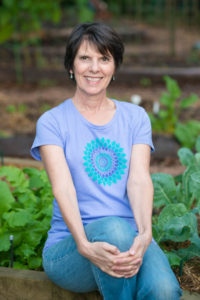Transition Time in the August Vegetable Garden
August is a transitional time in the vegetable garden as we clean up the remnants from summer and plan and prep for the milder days that will come. The first frost in Central Texas usually arrives in late November or early December which means we have over 3 months of frost-free weather ahead. Many gardeners concentrate on the array of cool season vegetables that thrive in fall’s cooler temperatures though there is also time for a fresh planting of green beans, cucumbers and squash, which start producing about two months after sowing seeds.
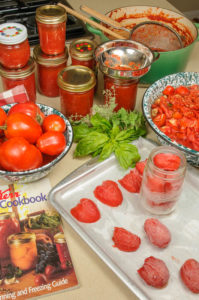
Preserve your tomato harvest by freezing, canning or dehydrating.
Create your Fall Gardening Plan
The size of your garden and what you like to eat will largely determine what you decide to plant. Think about the space each vegetable requires to reach harvest size, sketch your plan for fall and check the Vegetable Garden Planting Guide for recommended planting dates. It may seem counterintuitive to start planting during the hottest and driest time of the year but if you wait until the temperature is just right, which could be October or even November, that first frost could damage young or tender plants. In spring we plant early and protect our plants from cold weather and high winds and in fall we plant early and protect our plants from excess heat and blazing sun. That’s gardening in Texas!
August Vegetable Garden Checklist:
Water
- Be sure to watch the forecast and turn off automatic sprinklers or timers if rain is in the forecast.
- Water new seedlings regularly; direct sun combined with high temperatures can be a death sentence for a tender seedling without an established root system.
- Water container plants often, daily if needed, to provide sufficient moisture.
Soil/Mulch
- In preparation for planting spread a 2-inch layer of compost over garden beds and mix it in lightly. Water the area well before planting seeds or transplants.
- A layer of mulch is an important component for the vegetable garden; it moderates soil temperature, deters weeds, helps conserve moisture and gradually breaks down and enriches soil. Dried grass clippings, leaves, organic straw, partially decomposed compost and shredded bark are suitable options.
Fertilize
- As tomatoes, eggplants and peppers begin to flower and form fruit give them a boost with an application of water-soluble fertilizer according to label directions. If using a granular garden fertilizer spread 1-2 tablespoons around the base of each plant, scratch it in lightly and water well.
Plant/Transplant
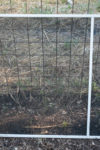
An old window screen provides temporary shade and protects new plantings from intense sun and heat.
- Shade young seedlings and transplants from direct afternoon sun. Use what you have on hand – an old window screen, shade cloth, sheets, cardboard or umbrellas. Get creative. It isn’t permanent and it doesn’t have to look pretty but it will give your plants a fighting chance.
- If you have decided to grow green beans, squash or cucumbers plant seed in late August or early September. For best results choose varieties that mature in less than 60 days and be prepared to water regularly until they are established.
- Take into account that milder temperatures and shorter days will slow the growth of fall plantings.
Diseases/Pests
- Watch for aphids on tender leafy growth; they can be easily dispatched with a strong spray of water.
Harvest
- Thanks to generous rains and milder temperatures in July many gardeners are still harvesting good-looking tomatoes. Make the most of the bounty by freezing, canning, oven-roasting or dehydrating.
- Pick peppers, eggplant and okra frequently. Okra pods should be picked when they are about 3-5 inches long and still tender.
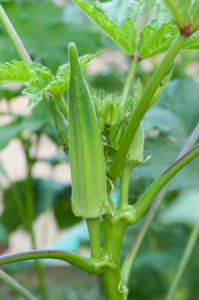
The edible quality of okra is best when pods are 3-5” long.
- Eggplant should be shiny and firm, and most peppers can be consumed when green or can be left on the plant to mature to red, orange, purple or yellow, depending on variety.
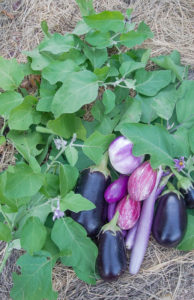
Harvest eggplant when the skin is still shiny; the variety determines the shape, size and color.
- Southern peas can be harvested when pods are immature and peas are tender or pods can be allowed to dry completely on the vine, then peas can be shelled and stored for delicious and nutritious winter meals. Either way be sure the pods make it to the compost pile.
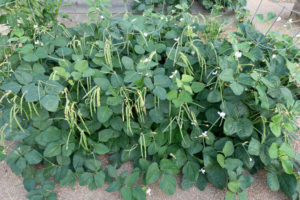
Southern peas, like these black-eyed peas, can be dried and shelled for winter meals.
Maintenance
- Pull or hoe weeds around the vegetable garden – they compete with young plants for water and nutrients. Green, leafy weeds are an excellent nitrogen source for the compost pile.
- Prune out dead stems and rangy growth of thyme, oregano, sage and other perennial herbs.
Tips
- If possible, garden during the mornings or evenings. If you must be outside during the hottest time of the day apply sunscreen, wear a wide brim hat, stay hydrated and take frequent breaks.
- Mosquitoes can be a major pest, especially with July’s unseasonable wet weather. Eliminate breeding grounds by cleaning out any sources of standing water and treat water in birdbaths and rain barrels with a product containing Bacillus thuringiensis israelensis (Bti). When working outside wear loose fitting, light-colored long sleeves and long pants and spray clothing with a repellent containing DEET or oil of lemon or eucalyptus. A mosquito hat or head net, found at camping stores or online, can be very effective at keeping mosquitoes away from the face.
Additional Resources
Watch the Vegetable Gardening in Central Texas Webinar
Recommended Vegetable Varieties for Travis County
Plant Rotations, Successions and Intercropping
Sustainable Food Center Farmers Markets
Monthly Gardening Calendar for Austin and Central Texas
